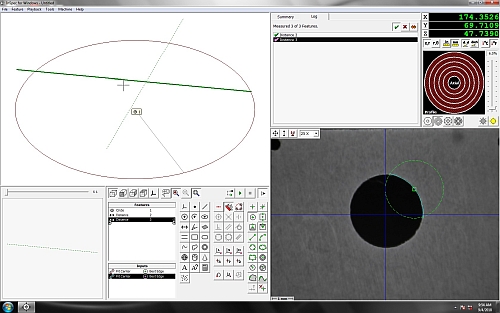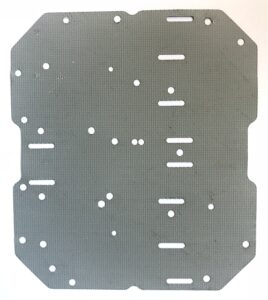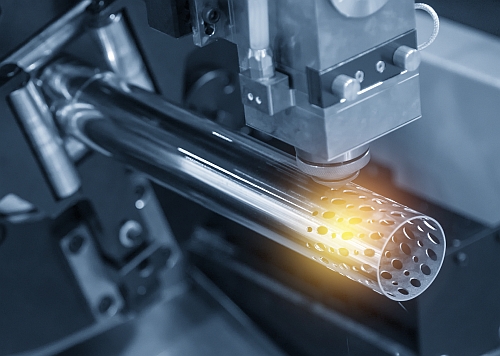Precision Laser Drilling
Laser Drilling
Why do people and manufacturing companies now use laser drilling?
At Laser Advantage, we have a variety of CO2, YAG and fiber lasers for precision drilling. Our capabilities are up to 1/4 in thickness for carbon steels, up to 1/8 in thickness in Stainless Steel, 3/4 for plastics and up to an inch for woods. We can also provide micro-hole drilling down to .005.
Positioning tolerances are as small as .001 and part tolerances are as low as .003 with table capacities ranging from 12X12 up to 40X80. And several of our machines include rotary as well as Z axis stages. Materials can be processed with Argon, Air, Oxygen or Nitrogen. With the use of CAD/CAM software, we can cut almost any geometry that can be provided by our customer.
Laser Drilling Has Come A Long Way
Laser drilling was used primarily for laser cutting, when it was first incorporated into manufacturing processes. That was about 50 years ago. Over time, the techniques have adapted, expanded and now can be applied through a variety of clear-cut laser drilling processes.
What is laser drilling?

Inspection of hole drilling in stainless steel
The laser drilling process can be used to make large or small multi-dimensional holes on a multitude of materials. For example, holes can be “through holes” for air-cooling vents. When needed, the drilling process simply puts dents (vs. holes) into the material to rough it up for adhesive applications. The intention is that of conventional drilling, but the laser drill uses a fiber laser beam, which is more accurately controlled and thus more efficient and cost effective.
Another key improvement between laser drilling over conventional drilling is that laser drilling is a no contact application. Since the laser does not physically touch the material it is working on, the process preserves the original quality of the material.
How does the laser drilling process work?
Although there are different types of laser drilling, each one basically works by concentrating on a particular area, focusing the beam to the size hole/indentation needed. Of course, there are several elements and materials in play first and foremost, the laser beam, which is emitted from a nozzle close to the material being shaped. The heat output generated from the intensity of the beam melts the excess material away from the beam focal point resulting in molten material within the hole (as well as the expelled molten material), and a vapor discharged from the new holes. The pressure from the vapor created during the process pushes out the melted excess material, leaving a hole (or dent) underneath. The process is quick, usually able to drill holes at a rate of 0.3 and 3 holes per second. It follows then that the greater the power of the pulsed laser in use, the more material that will be melted and vaporized.
What are primary types of laser drilling?

There are four different types used in machining, and these include:
1) Helical laser drilling
2) Percussion laser drilling
3) Single-shot laser drilling
4) Trepan laser drilling
Of these techniques, single-pulse is the most basic and is very effective in creating a large number of holes in a short amount of time. Trepan laser drilling basically works like single pulse drilling, however, it can create shapes used for creating cross sections, including use for refining the shape of 3D forms. Percussion drilling, also works similarly to single-shot. However, the size of the beam is adjustable in percussion drilling, so the holes being drilled can be set to be deeper and more precise than those created with the single-pulse method. Helical laser drilling uses the basic platform that single-shot and percussion drilling employ. The big difference is when using helical laser drilling, there is the option to adjust the laser beam. The helical laser beam is kept focused at the base of the project and is usually applied to creating very deep and much larger holes than the other methods allow. Another difference is this process shoots the leftover molten material upwards whereas the other processes push it down.
What are the advantages of laser drilling over conventional drilling?
[ Laser drilling in medical devices
Laser drilling in medical devices
Laser drilling is the more efficient and versatile type of drilling and outperforms conventional drilling in every situation. For example, laser drilling works with a single set-up on a single machine. It has a large capacity to work across numerous substances, such as diamond, glass, metal (including stainless steel), plastic and even rubber. The laser beam can be directed to provide the machine operator control over all steps in the drilling process, including duration and intensity, as well as heat output. The precision and uniqueness of laser drilling has been proven successful in the major manufacturing industries, including medical, aerospace, automotive, and electrical and its relative subcategories. Because laser drilling is a non-contact process, it exhibits minimal distortion to materials in use and highly desirable for a more cost-effective result. Money is also saved because production rates increase when set-up is faster and less tooling is involved.
Another advantage of the laser drilling process is that you can choose which of the methods will be suit your needs. For example, single-shot will be quick if needed but for more precision, the helical laser process will work best. Basically, because of the precision available, laser drilling is used for drilling shallow angles and holes. The laser drilling processes are flexible, and are successfully applied for changes to prototypes, small jobs, and application of several features into one material simultaneously.
Why do people and manufacturing companies now use laser drilling?
In short, technology is pushing us to be more innovative and we are continually working on more complex products. The precision of laser drilling has allowed industries to service the need for creating very small holes and large depth-to-diameter ratio holes, which conventional drilling can no longer create in an efficient, cost effective manner. Medical devices are a particular industry that demands drilling to meet the needs of their highly-developed, sensitive equipment requiring the precision and speed of the laser drilling process.
Get a Quote
Get in touch with us to discuss your needs.